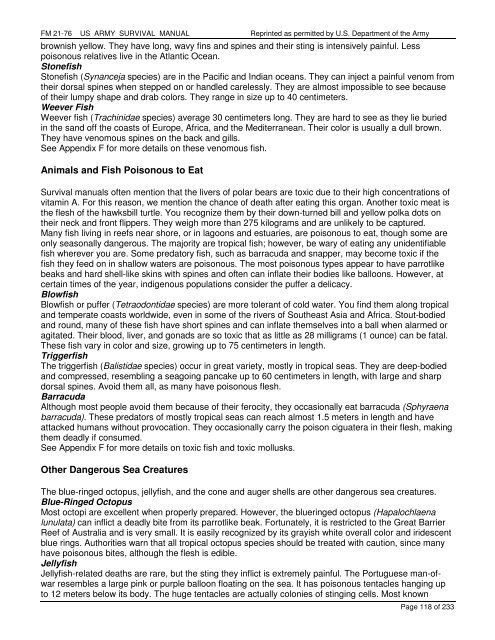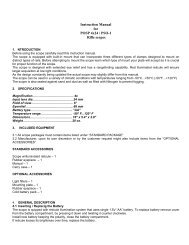FM 21-76 US ARMY SURVIVAL MANUAL - AR15.com
FM 21-76 US ARMY SURVIVAL MANUAL - AR15.com
FM 21-76 US ARMY SURVIVAL MANUAL - AR15.com
You also want an ePaper? Increase the reach of your titles
YUMPU automatically turns print PDFs into web optimized ePapers that Google loves.
<strong>FM</strong> <strong>21</strong>-<strong>76</strong> <strong>US</strong> <strong>ARMY</strong> <strong>SURVIVAL</strong> <strong>MANUAL</strong> Reprinted as permitted by U.S. Department of the Army<br />
brownish yellow. They have long, wavy fins and spines and their sting is intensively painful. Less<br />
poisonous relatives live in the Atlantic Ocean.<br />
Stonefish<br />
Stonefish (Synanceja species) are in the Pacific and Indian oceans. They can inject a painful venom from<br />
their dorsal spines when stepped on or handled carelessly. They are almost impossible to see because<br />
of their lumpy shape and drab colors. They range in size up to 40 centimeters.<br />
Weever Fish<br />
Weever fish (Trachinidae species) average 30 centimeters long. They are hard to see as they lie buried<br />
in the sand off the coasts of Europe, Africa, and the Mediterranean. Their color is usually a dull brown.<br />
They have venomous spines on the back and gills.<br />
See Appendix F for more details on these venomous fish.<br />
Animals and Fish Poisonous to Eat<br />
Survival manuals often mention that the livers of polar bears are toxic due to their high concentrations of<br />
vitamin A. For this reason, we mention the chance of death after eating this organ. Another toxic meat is<br />
the flesh of the hawksbill turtle. You recognize them by their down-turned bill and yellow polka dots on<br />
their neck and front flippers. They weigh more than 275 kilograms and are unlikely to be captured.<br />
Many fish living in reefs near shore, or in lagoons and estuaries, are poisonous to eat, though some are<br />
only seasonally dangerous. The majority are tropical fish; however, be wary of eating any unidentifiable<br />
fish wherever you are. Some predatory fish, such as barracuda and snapper, may become toxic if the<br />
fish they feed on in shallow waters are poisonous. The most poisonous types appear to have parrotlike<br />
beaks and hard shell-like skins with spines and often can inflate their bodies like balloons. However, at<br />
certain times of the year, indigenous populations consider the puffer a delicacy.<br />
Blowfish<br />
Blowfish or puffer (Tetraodontidae species) are more tolerant of cold water. You find them along tropical<br />
and temperate coasts worldwide, even in some of the rivers of Southeast Asia and Africa. Stout-bodied<br />
and round, many of these fish have short spines and can inflate themselves into a ball when alarmed or<br />
agitated. Their blood, liver, and gonads are so toxic that as little as 28 milligrams (1 ounce) can be fatal.<br />
These fish vary in color and size, growing up to 75 centimeters in length.<br />
Triggerfish<br />
The triggerfish (Balistidae species) occur in great variety, mostly in tropical seas. They are deep-bodied<br />
and compressed, resembling a seagoing pancake up to 60 centimeters in length, with large and sharp<br />
dorsal spines. Avoid them all, as many have poisonous flesh.<br />
Barracuda<br />
Although most people avoid them because of their ferocity, they occasionally eat barracuda (Sphyraena<br />
barracuda). These predators of mostly tropical seas can reach almost 1.5 meters in length and have<br />
attacked humans without provocation. They occasionally carry the poison ciguatera in their flesh, making<br />
them deadly if consumed.<br />
See Appendix F for more details on toxic fish and toxic mollusks.<br />
Other Dangerous Sea Creatures<br />
The blue-ringed octopus, jellyfish, and the cone and auger shells are other dangerous sea creatures.<br />
Blue-Ringed Octopus<br />
Most octopi are excellent when properly prepared. However, the blueringed octopus (Hapalochlaena<br />
lunulata) can inflict a deadly bite from its parrotlike beak. Fortunately, it is restricted to the Great Barrier<br />
Reef of Australia and is very small. It is easily recognized by its grayish white overall color and iridescent<br />
blue rings. Authorities warn that all tropical octopus species should be treated with caution, since many<br />
have poisonous bites, although the flesh is edible.<br />
Jellyfish<br />
Jellyfish-related deaths are rare, but the sting they inflict is extremely painful. The Portuguese man-ofwar<br />
resembles a large pink or purple balloon floating on the sea. It has poisonous tentacles hanging up<br />
to 12 meters below its body. The huge tentacles are actually colonies of stinging cells. Most known<br />
Page 118 of 233








